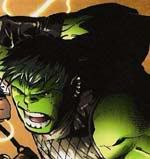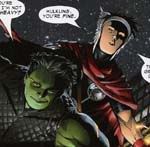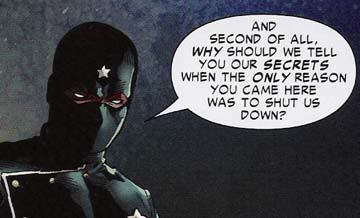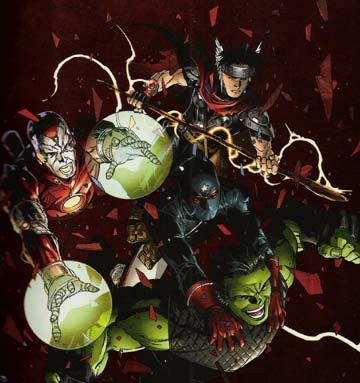Review- Young Avengers: Sidekicks
 Young Avengers: Sidekicks
Young Avengers: SidekicksScript by Allan Heinberg, art by Jim Cheung
Published by Marvel; $19.99 US (hardcover edition)
Collects Young Avengers #1-#6
In the wake of "Avengers Disassembled" a new team of teenage superheroes emerges, mimicking former members of the disbanded Avengers. Met with a distrustful public, an inquisitive Daily Bugle reporter, disapproving former Avengers, and a time-traveling warlord, this new band of super-teens will have to deal with a hell of a lot more than puberty in order to survive Young Avengers: Sidekicks.
I didn’t realize how much I’d missed Jim Cheung’s work on Scion until I read Young Avengers. His work remains crisp and clean, and is complemented wonderfully by Jim Ponsor’s colors. My only very minor complaint is that Cheung’s apparent dislike for motion lines makes some of the action sequences stiff to the point where there are times when it’s not clear what’s going on. For example, in the second chapter Hulkling is cut by a drug dealer’s knife, though it looks like the guy actually missed. You don’t find out he actually found his mark until two panels later when Hulkling assures his buddies that he’s "almost healed." Likewise, a villain’s sword passes through an intangible character in chapter 5, though at first it looks like he’s just holding the sword rather than swinging it. It’s nitpicky, and I noticed similar instances in Scion.

I haven’t watched many of the TV shows that Heinberg’s worked for (The O.C., Gilmore Girls, and Sex and The City, among others), and haven’t been a big fan of the ones I have, but his first foray into the world of superheroes doesn’t fail to impress. His super-guys are multi-dimensional and refreshingly fallible, filled with both the doubt and defiance any teenager knows. The concept itself was just a bit of genius. It’s difficult to endear superhero comics fans to brand new characters, so Heinberg conceived a team with the guise of connection to established characters, only to reveal those connections were thin at best (or, at least, the wires didn’t cross where everyone expected them to). The newness of the characters allows Heinberg more freedom than he might have working on established supers, keeping the readers guessing about the origins of the characters involved.
 (FANBOY INTERLUDE: Being the ever-vigilant Hulk afficionado, I had a pair of theories about Hulkling which both proved incorrect. One involved a story from The Incredible Hulk Annual 1997 in which the Hulk and Gladiator fought over a child clone of Bruce Banner. The other was that he might be the son of the Maestro: the tyrannical, futuristic version of the Hulk from The Incredible Hulk: Future Imperfect. The Maestro was resurrected in one of Peter David’s last issues, The Incredible Hulk #461, and ended up buried under a big pile of rocks at the end of the issue, but if you don’t see a body . . . I was wrong but, as a drunken would-be passenger on Airline once said, "I may be wrong, but I’m all about bein’ RIGHT!")
(FANBOY INTERLUDE: Being the ever-vigilant Hulk afficionado, I had a pair of theories about Hulkling which both proved incorrect. One involved a story from The Incredible Hulk Annual 1997 in which the Hulk and Gladiator fought over a child clone of Bruce Banner. The other was that he might be the son of the Maestro: the tyrannical, futuristic version of the Hulk from The Incredible Hulk: Future Imperfect. The Maestro was resurrected in one of Peter David’s last issues, The Incredible Hulk #461, and ended up buried under a big pile of rocks at the end of the issue, but if you don’t see a body . . . I was wrong but, as a drunken would-be passenger on Airline once said, "I may be wrong, but I’m all about bein’ RIGHT!") The one thing that’s probably earned the series most of its attention - the nature of the relationship between Asgardian and Hulkling - is hinted at first, and all but obvious by the end of the collection. I can’t decide whether or not I think it’s a good thing that this inspired so much Internet debate. It’s good to get it out in the open, and Heinberg doesn’t whore the relationship out as a controversy that will support the book all on its own. It’s handled respectfully and without propaganda from either side of the aisle, and the heroes’ orientation doesn’t seem to have any more significant impact on their relations with the rest of the group than Patriot’s skin color does on his. Still, it would be a shame if five years from now the only thing people have to say about this series is, "There was gays!"
The one thing that’s probably earned the series most of its attention - the nature of the relationship between Asgardian and Hulkling - is hinted at first, and all but obvious by the end of the collection. I can’t decide whether or not I think it’s a good thing that this inspired so much Internet debate. It’s good to get it out in the open, and Heinberg doesn’t whore the relationship out as a controversy that will support the book all on its own. It’s handled respectfully and without propaganda from either side of the aisle, and the heroes’ orientation doesn’t seem to have any more significant impact on their relations with the rest of the group than Patriot’s skin color does on his. Still, it would be a shame if five years from now the only thing people have to say about this series is, "There was gays!" Not only does making the spin-offs of two of Marvel’s biggest super-masculine rivals gay lovers sit much better with me than having fans roar their throats raw over Hulk/Thor versus debates, but it’s disappointing to find so many Hulk-nuts who’d like to stuff Hulkling’s head down a toilet and flush until he turns blue. Maybe I’m one of a small number of Hulk readers who remember that it was Peter David’s original Hulk run that brought us some of the first respectful portrayals of homosexuals in superhero comics. I really don’t care if he’s gay or not. It’s just refreshing to read a Hulk guy who can kick ass; but is more human, fallible, and likeable (and I actually dig his outfit, though I’ll always prefer the purple shredders on the original green guy).
On a sidenote, I’m curious about the Vision’s involvement in the series. While I’ve only read the first collection, I’ve spotted him on the covers of later issues, suggesting he has an ongoing relationship with the team. Considering he was apparently the one who indirectly formed the Young Avengers, I’m curious about whether or not the similarity to Young Justice (which featured a previously deactivated android - the Red Tornado - acting as mentor to a group of teen heroes) is homage, subconscious theft, or pure accident (I’m not making any kind of creative indictments regardless, just curious).
My only concern with Heinberg’s writing is that the importance placed on ongoing mysteries, while engaging in this first collection, may threaten Young Avengers’s survival as an continuing series. Nearly a third of the first chapter deals with nothing but Daily Bugle regulars like Jessica Jones and J. Jonah Jameson mulling over some of the same mysteries that have fans theorizing on the Internet. Where did they come from? What’s the nature of their powers? What’s the exact nature of the relationship between Hulkling and Asgardian? What does the Vision have to do with it all? Why didn’t the android tell anyone of his plans? What are their connections to the Avengers?

You could call it the Twin Peaks Syndrome or, making it more funnybook-relevant, the Thunderbolts Syndrome. First, once the mysteries are revealed, will the readers care (just as Twin Peaks viewers dropped away once Laura Palmer’s killer was revealed)? Second, is Heinberg threatening the potential of new readership by hinging so much of it on ongoing mysteries? I jumped on the first Thunderbolts series after Nicieza took the reins, and quickly jumped away, confused by the half-dozen or so ongoing mysteries that were enthralling the guys who’d been reading since day one. I mean, if you start on the series the issue before you find out "WHO’S IN THE THIRD POD?!?!?!" you’re not going to give a shit about "WHO’S IN THE THIRD POD?!?!?!"
But it’s too early to nay-say, and so far Young Avengers has earned its spurs. For now, this Hulkling’s impressed, and he aims to stay.



1 Comments:
Yo there fellow YA fan! hahas nice GREEN blog!
Post a Comment
<< Home